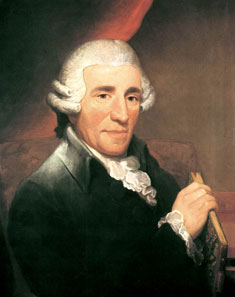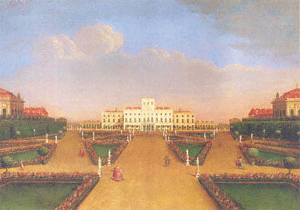

(Franz) Joseph Haydn (1732- 1809) composed his Emperor Quartet, Op. 76, No. 3 in 1797. Haydn (known as Joseph, not Franz to his peers) was an Austrian composer who excelled in virtually all genres of music popular during the Classical period. He was particularly noted for his contributions to the forms of quartets and symphonies. When Haydn was a young boy, he traveled to Vienna to sing as a choirboy at the St. Stephen's Cathedral, and he remained there for the next ten years as he sang in the choir and received a musical education at the choir school. When his voice "broke" (a natural change which occurs in the voice of an adolescent boy), Haydn was no longer able to sing with the boys choir, and the next phase of his life was rather difficult. Haydn described this period in the following words:
When my voice finally broke, for eight whole years I was forced to eke out a wretched existence by teaching young people. Many geniuses are ruined by this miserable [need to earn their] daily bread, because they lack time to study. This could well have happened to me; I would never have achieved what little I have done, had I not carried on with my zeal for composition during the night. I composed diligently, but not quite correctly, until I finally had the good fortune to learn the true fundamentals of composition from the famous Porpora (who was in Vienna at the time). Finally, owing to a recommendation from the late [Baron] von Fürnberg (who was especially generous to me), I was appointed as director with Count Morzin, and from there as Kapellmeister with his highness Prince [Esterházy]. [5]

In 1761, Haydn entered the service of Prince Esterházy, a wealthy Hungarian nobleman whose family was famous for their patronage of the arts. For nearly thirty years, Haydn was employed by the Esterházy family, and he composed the majority of his musical works while living in Esterháza, the Esterházy family's palace (during this time, Esterháza was one of the finest palaces in Europe, and even had its own opera house, and two concert halls).
Although Esterháza was somewhat isolated from Europe's musical scene (it was outside of Vienna), Haydn's reknown gradually spread throughout Europe. Following the death of Haydn's patrons (Prince Paul Anton and later his brother Prince Nikolaus), Haydn moved to Vienna and commenced entrepreneurial ventures selling his music to publishers and to individual clients.
Haydn composed his Quartet in C major, Op. 76, No. 3 in 1797. It is known as the Emperor Quartet due to the fact that Haydn based the melody in the second movement on the Austrian Emperor's Hymn, a piece which Haydn had composed at the request of government officials (Haydn completed the Emperor's Hymn in early 1797). The Emperor's Hymn was first sung in honor of the emperor's birthday, and became so popular, that it later became the national anthem of Austria and Germany.
TECHNIQUE TIPS: This piece is an arrangement of the second movement, Andante, from Haydn's Emperor Quartet. This movement is in the small form of theme and variations. In this arrangement, the theme of the Emperor's Hymn is stated in the first 20 measures of this piece, and then one, simplified variation of the theme is presented (in Haydn's full score of this movement, four variations of the theme are presented). The tempo of this piece is poco adagio cantabile, meaning it should be played with a singing style of playing, and a rather slow and leisurely tempo. Since this melody was composed in honor of the Emperor (and was also used as Austria's national anthem), play the melody in a flowing, majestic and singing manner. The simplified variation of the theme used in this arrangement (measures 21 to the end), is based on a version found in T. Mee Pattison's Maidstone Violin Tutor, published in London in c.1897. [6]
© Copyright 2025 RK Deverich. All rights reserved.
Although this online bass class is provided free of charge, all rights are reserved and this content is protected by international copyright law. It is illegal to copy, post or publish this content in any form, and displaying any of this material on other websites, blogs or feeds is prohibited. Permission is given for individual users to print pages and perform music from this website for their personal, noncommercial use.